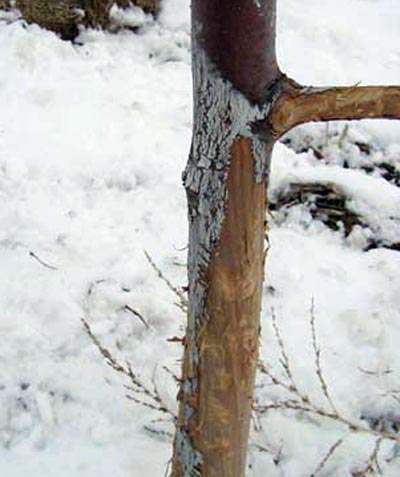Winter snow cover leading to increased rabbit damage for fruit and landscape plants
Signs to look for and management considerations for rabbit damage to fruit and landscape plants.

We are all very much aware that the 2013-2014 winter precipitation in Michigan has been higher than normal. Over 90 inches of snow have fallen on the Ridge, a well-known tree fruit growing region located northwest of Grand Rapids, Mich. Michigan State University Extension colleagues in the northwest region of Michigan’s Lower Peninsula, a region known for growing over 70 percent of the nation’s tart cherries, tell me they’ve had over 180 inches – amazing! In the Grand Rapids tree fruit area, snow cover is up to the lowest scaffold limbs in many tree fruit orchards, something that hasn’t been seen for many years. Also, many landscape trees and shrubs are completely or partially covered by snow.
Every morning after a little light snow, fresh, new rabbit tracks, trails and droppings can be seen from their overnight activities. I see trails in my yard as well as in the woods and in orchards nearby. Rabbits do not hibernate in the winter and they are actively looking for food sources. When snow levels are not high, rabbits feed on vegetation at ground level. As the snow gets deeper and food sources are limited, rabbits travel and feed on vegetation near the surface of the snow. Therefore, rabbits will likely find apple limbs that are near the snow surface to be great food sources. Landscape plants, especially Euonymous alatus (burning bush), are also food sources for hungry rabbits.
Feeding damage is already being reported in orchards this year. In the winter, rabbits strip bark and debud fruit trees, conifers and other trees and shrubs. Trees clipped by rabbits have a clean, knifelike cut on the stems. Rabbits can clip stems 0.25 inches in diameter and can be especially damaging to nursery trees.

Rabbit damage to tree. Photo credit: Mark Longstroth, MSU Extension
In commercial orchard systems, painting tree trunks and scaffold limbs and using repellents may deter rabbits from causing damage, but these methods aren’t feasible during the heart of the winter months. Trapping and hunting are the only viable management methods for rabbit population management during this time of year. Rabbits rely on dense vegetation such as hedges, brush piles and overgrown stream banks for protection from predators. Eliminating these helps to reduce rabbit populations.
For backyard bunny issues, exclusion is probably the best method for the winter remaining. Fencing around susceptible trees and shrubs is advised, but certainly not easy to do right now due to deep snow. Any screening or fencing needs to be pushed down to at least ground level, which will be difficult in 2 feet of snow. Scare tactics don’t always work well for rabbits. A dog might help while it is outside, but family pets should not be left out during the cold and especially not at night, which is when rabbits are most active.
I wish to thank my MSU Extension colleague, Emily Pochubay and Bill Shane, for their contribution to this article.



 Print
Print Email
Email


